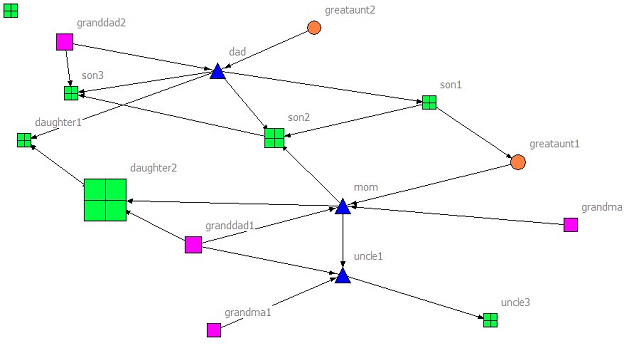Hello! I am Maryann Durland and I own an independent consulting firm, Durland Consulting and have been using Network Analysis (NA) since the early 1990’s and hence my focus on our evaluation network. My post today is about the methodology of NA in evaluation applications. First what is it, second how do you do it, and three what does it look like.
Hot Tip: Network analysis is the methodology for studying relationships among and between members of a set(s). A set can be people, references, roads and towns, organizations, and so on. Relationships defined for a set can be at three levels – individuals, subgroups or the whole set, and from a variety of contexts, such as friendships, co-membership in groups, related to and how, work with, readers of the same book, etc. To apply network analysis requires three components:
- Define the Network and the Relationship: In some applications the network is self defining – members of an extended family.
- Measures Used to Analyze the Data: The choice of measures is usually based on a theory about the relationship.
- The Sociogram: The sociogram illustrates the network and also allows us to see the position of individuals within the network to further understand the analysis and which may also indicate further data analysis.
| generation | shape | color |
| great | circle | orange |
| grand | square | pink |
| parent | triangle | blue |
| child | box x | green |
As an example, in family money exchanges, the data might indicate that dad loans to more people, but daughter 2 is engaged in larger loans. In the sociogram we see how location is important. The sociogram nodes’ size is related to the amount of money and shape and color are by generation.
We see that dad and mom have similar locations in the network and, except for son 2, they connect to different individuals, suggesting further analysis. Though daughter 2 is connected less as measured by outdegree, she is involved in larger loan amounts. Son 2 is in a pivotal location in the network, bridging mom and dad’s subgroups, indicating that subgroup membership might be another level of analysis.
 This provides a small glimpse into network analysis. What I like about network analysis is that it forces you to focus on how we assume behavior will play out in our initiatives like what do we assume mentors will do in a mentoring relationship? And it allows us to explore the complexity of our programs and initiatives. It requires thinking about the systems within which our initiatives are situated and it is fun.
This provides a small glimpse into network analysis. What I like about network analysis is that it forces you to focus on how we assume behavior will play out in our initiatives like what do we assume mentors will do in a mentoring relationship? And it allows us to explore the complexity of our programs and initiatives. It requires thinking about the systems within which our initiatives are situated and it is fun.
Rad Resource: Want to learn more about Social Network Analysis? An introductory text is available online at http://ow.ly/1rlcQ
This contribution is from the aea365 Daily Tips blog, by and for evaluators, from the American Evaluation Association. Please consider contributing – send a note of interest to aea365@eval.org.


Pingback: DVR Week: Johanna Morariu on Network Analysis and Mapping with Gephi and NodeXL · AEA365
Great example!
Thanks MaryAnn. I appreciated the reference but more importantly
the reminder about assumptions and how this approach can illuminate what is.